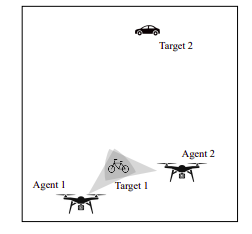The Emergence of Individuality
An overview of the paper “The Emergence of Individuality”. Individuality is key for multi-agent cooperation. The authors propose a simple yet efficient method for the emergence of individuality(EOI) in multi-agent reinforcemnet learning. All images and tables in this post are from their paper.
Introduction
Although multi-agent reinforcement learning (MARL) has been applied to multi-agent cooperation, it is widely ovserved that agents usually learn similar behaviors, especially when the agents are homogeneous with shared global reward and co-trained. For example, multi-camera multi-object tracking, where camera agents learn to cooperatively track multiple objects, the camera agents all tend to track the easy object. However, such similar behaviors can easily make the learned policies fall into local optimum. If the agents can respectively track different objects, they are more likely to solve the task optimally. EOI learns a probabilistic classifier that predicts a probability distribution over agents given their observation and gives each agent an intrinsic reward of being correctly predicted probability by the classifier. Encouraged by the intrinsic reward, agents tend to visit their own familiar observations.
Multi-camera multi-target capturing.

Methodology
Individuality is of being an individual separate from others. Motivated by this, the authors propose EOI, where agents are intrinsically rewarded in terms of being correctly predicted by a probabilistic classifier that is learned based on agents’ observations. If the classifier learns to accurately distinguish agents, agents should behave differently and thus individuality emerges.
Intrinsic Reward
To enable agents to develop indivuality, EOI learns a probabilistic classifier to predict a probability distribution over agents given on their observation, and each agent takes the correctly predicted probability as the intrinsic reward at each timestep. Thus, the reward function for agent
is modified as:
where is the global environmental reward,
is the predicted probability of agent
given its observation
, and
is a tuning hyperparameter to weight the intrinsic reward.
Regularizers of )
The previous section would not work if there is no difference between agents’ policies. However, in general, the difference between initial policies is small (even no differences if agents’ policies are initially by the same network weights), and policies will quickly learn similar behaviors as mentioned in Figure-1. To address this issue, the authors propose two regularizers: positive distance (PD) and mutual children (MI) for learning .
Positive Distance: The positive distance is inspired from the triplet loss in contrastive learning, which is proposed to learn identifiable embeddings. The positive distance minimizes the intra-distance between the observations with the same “identity”, which hence enlarges the margin between different “identities”. As a result, the observations become more identifiable.
Mutual Information
If the observation are more identifiable, it is easier to infer the agent that visits the given observation most identifiable, it is easier to infer the agent that visits the given observation most, which indicates the higher mutual information between agent index and observation.Therefore, to further increase the discriminability of the classifier, we maximize their mutual information.
Conclusion
The authors propose a novel approach EOI for the emergence of individuality in MARL. EOI learns a probabilistic classifier that predicts a probability distribution over agents given their observation and gives each agent an intrinsic reward of being correctly predicted by the classifier.
